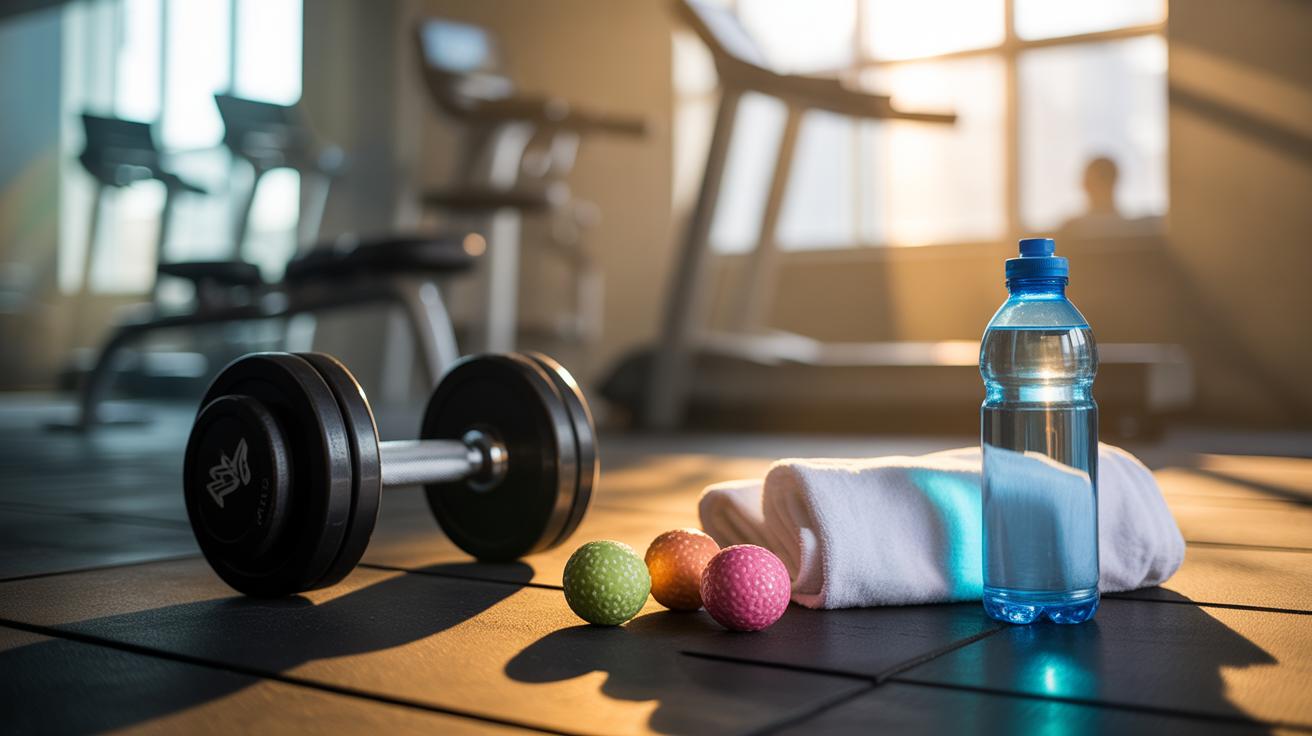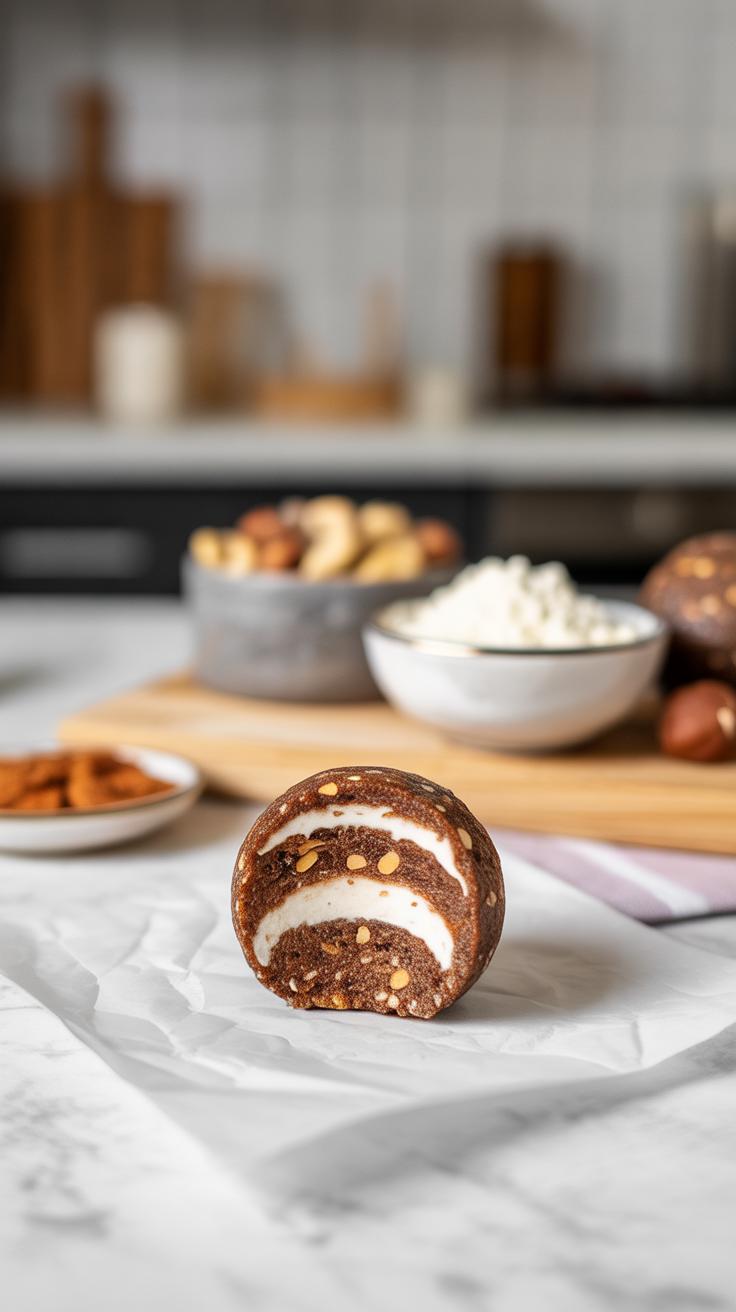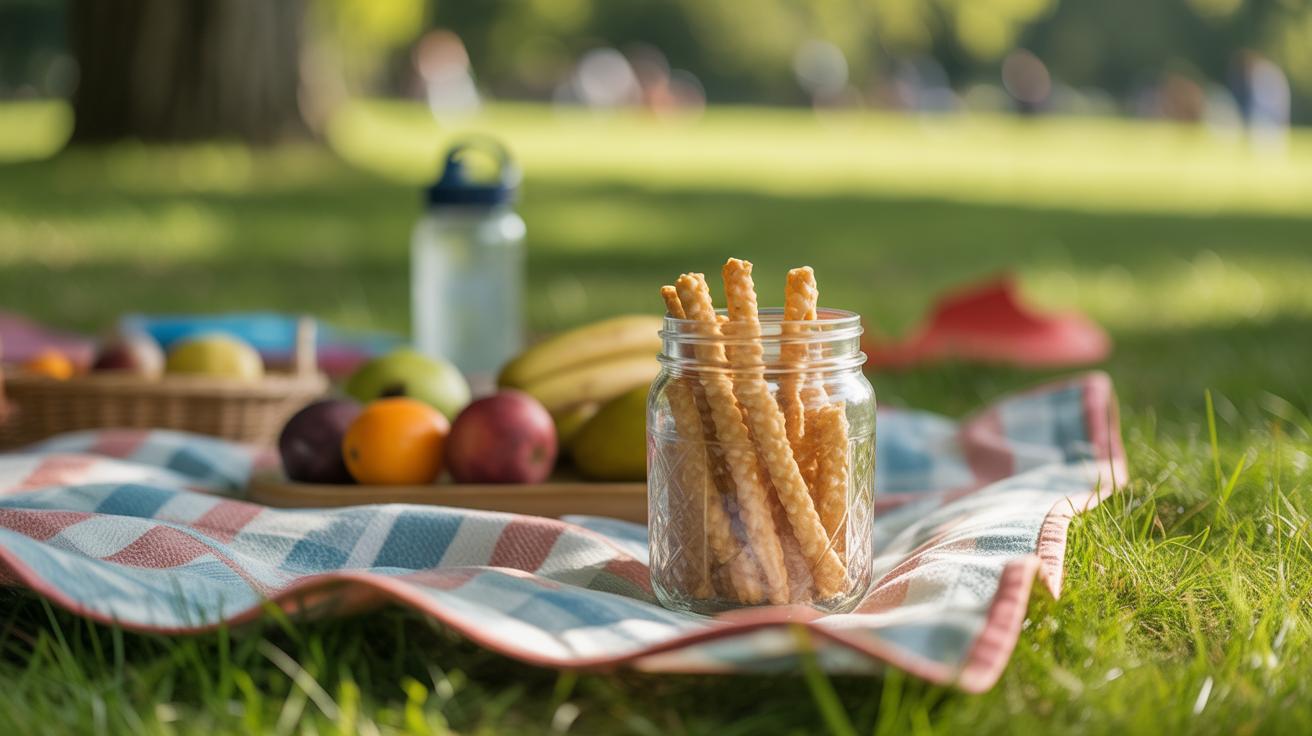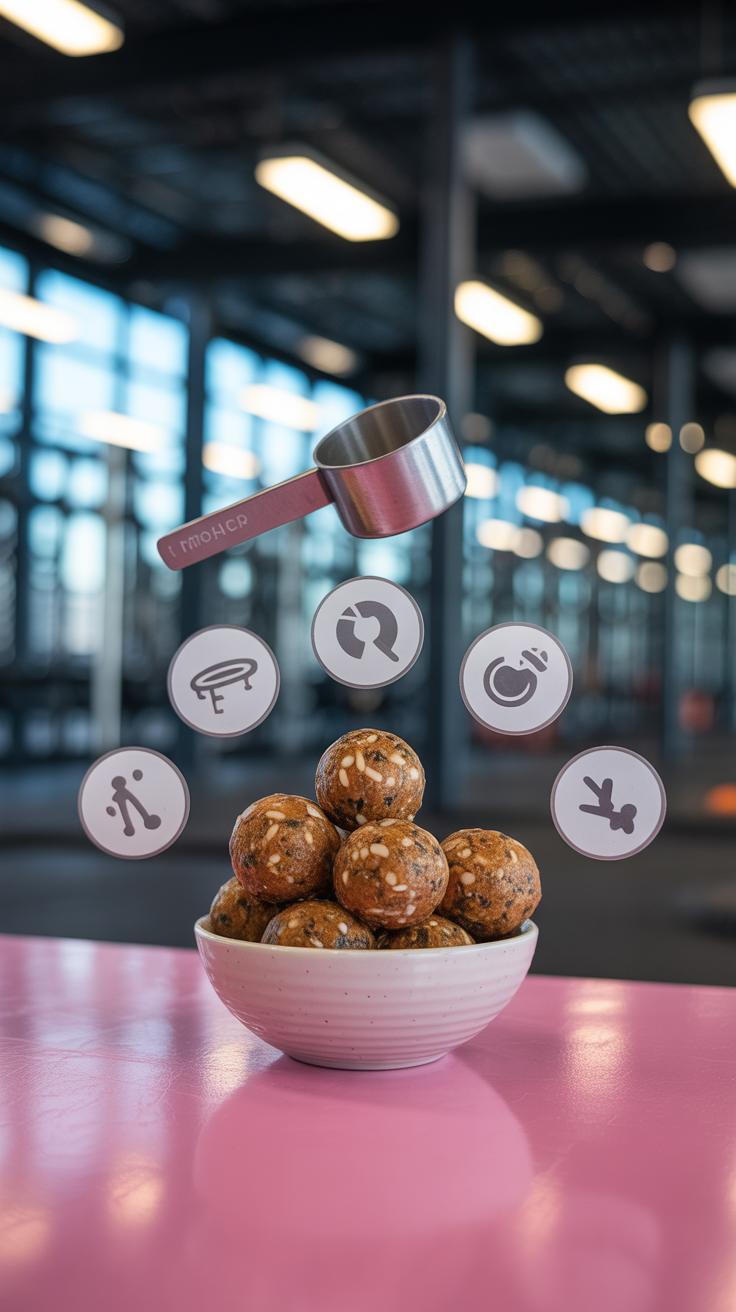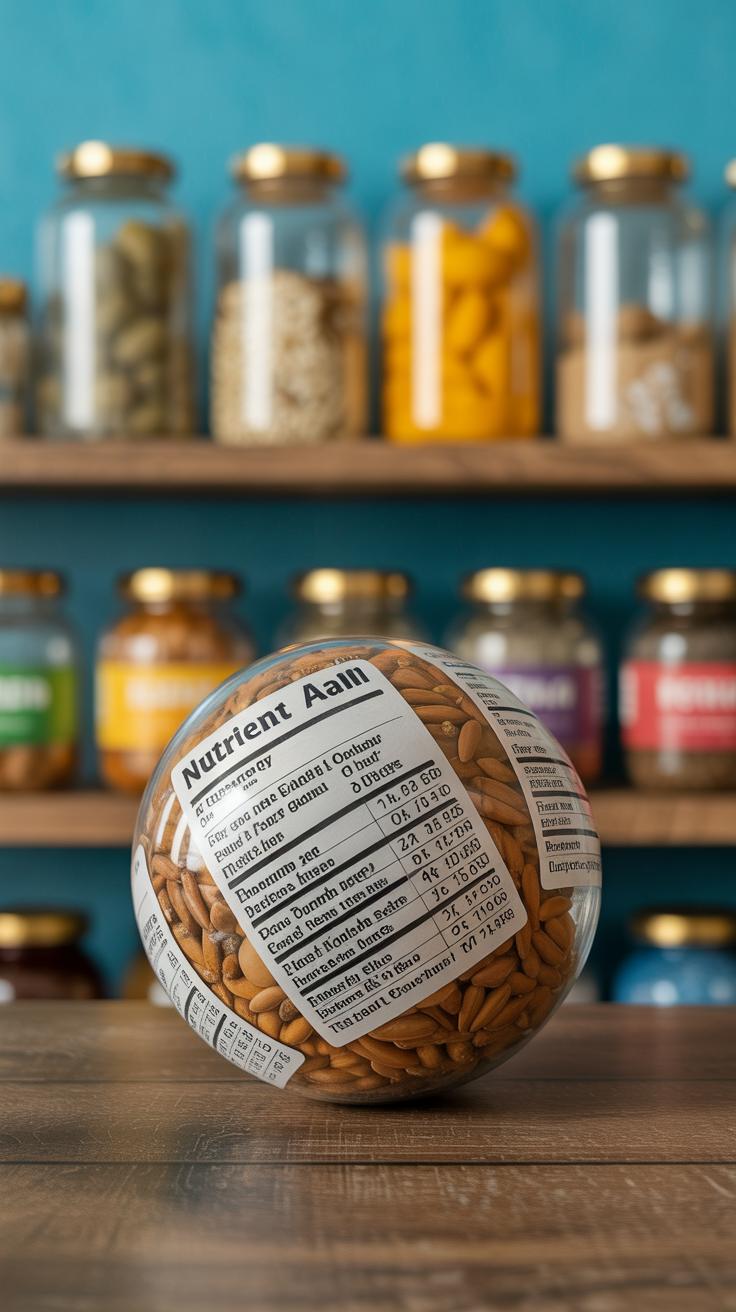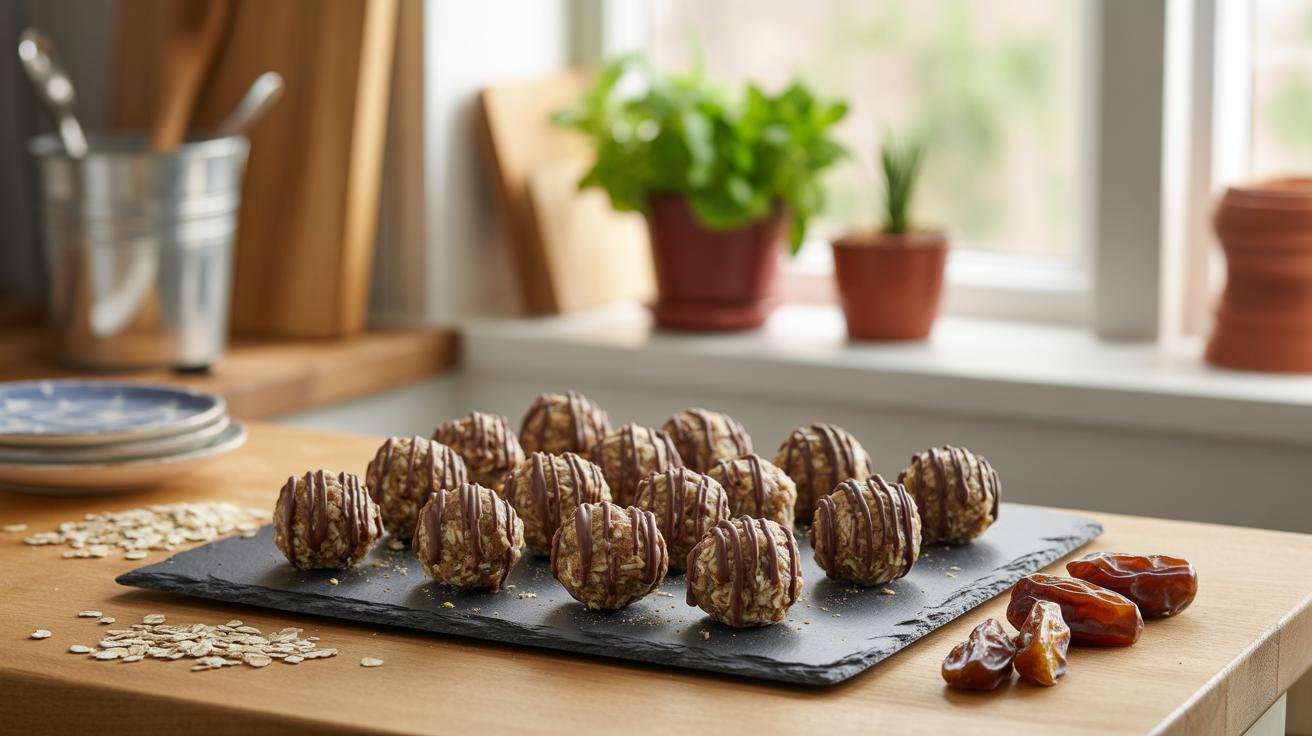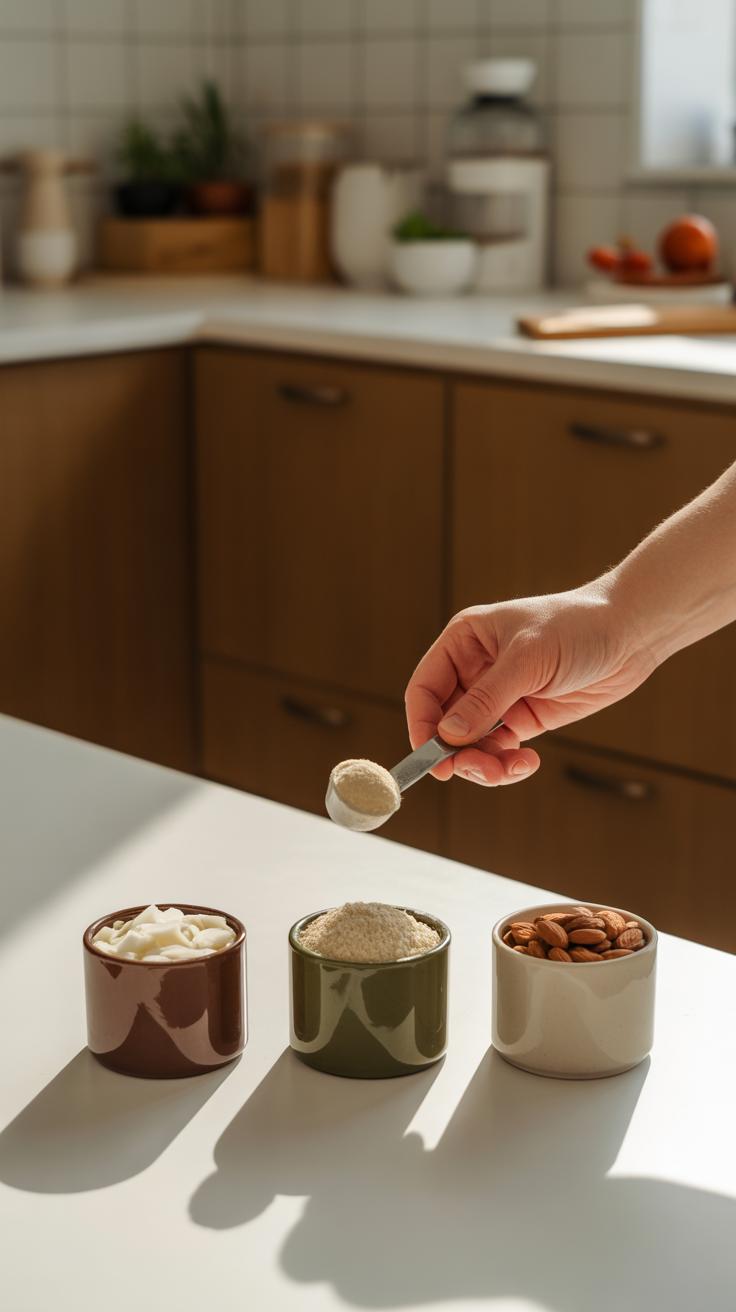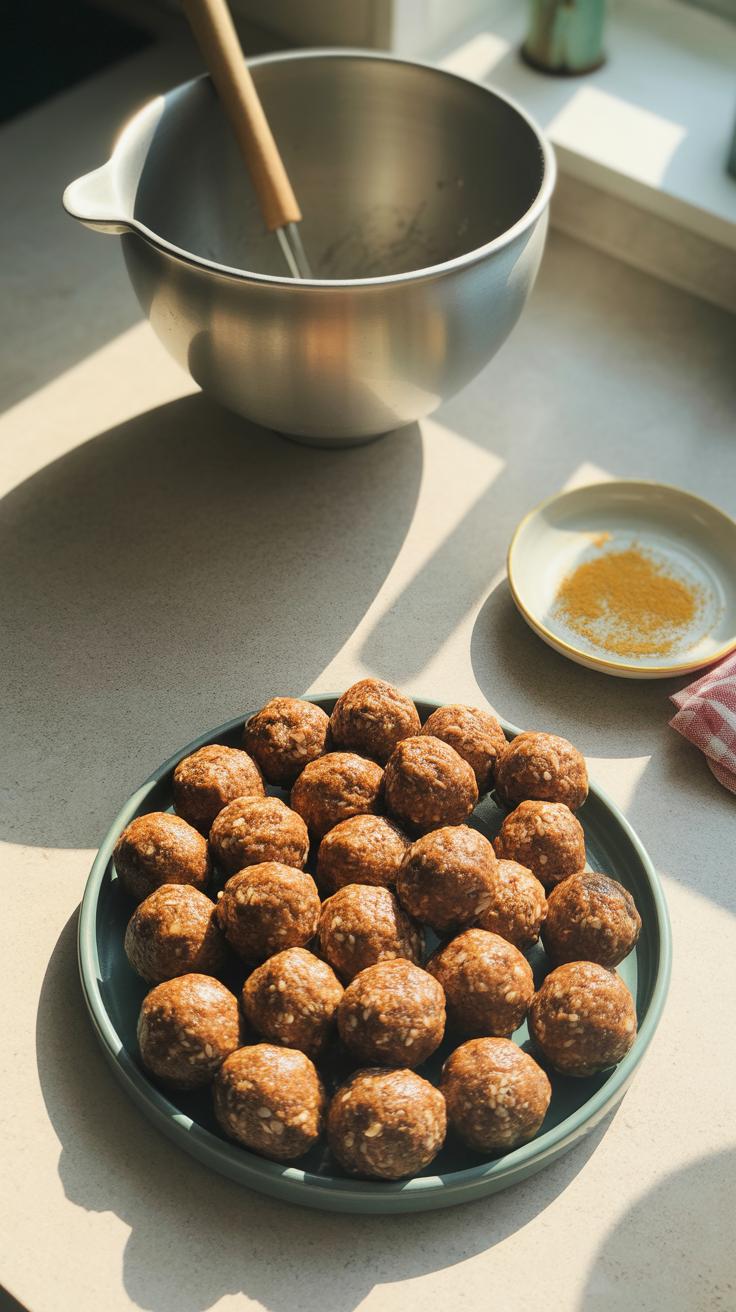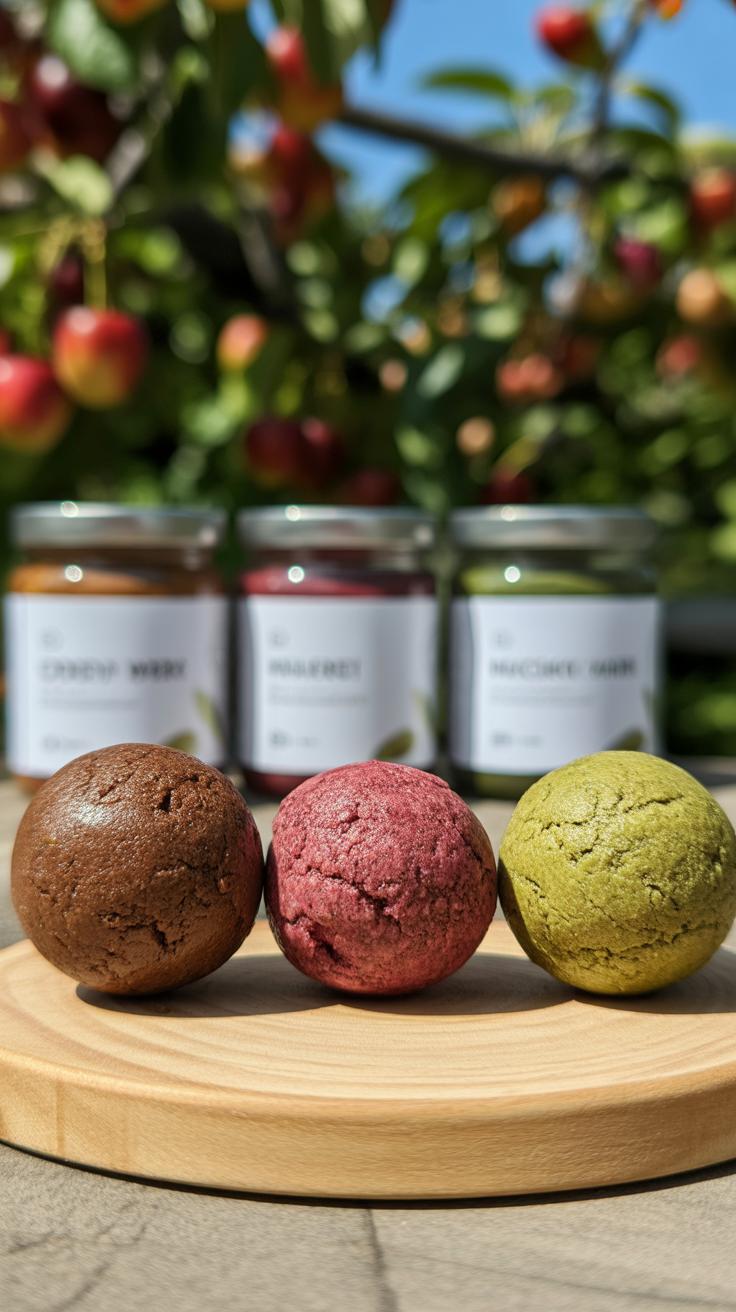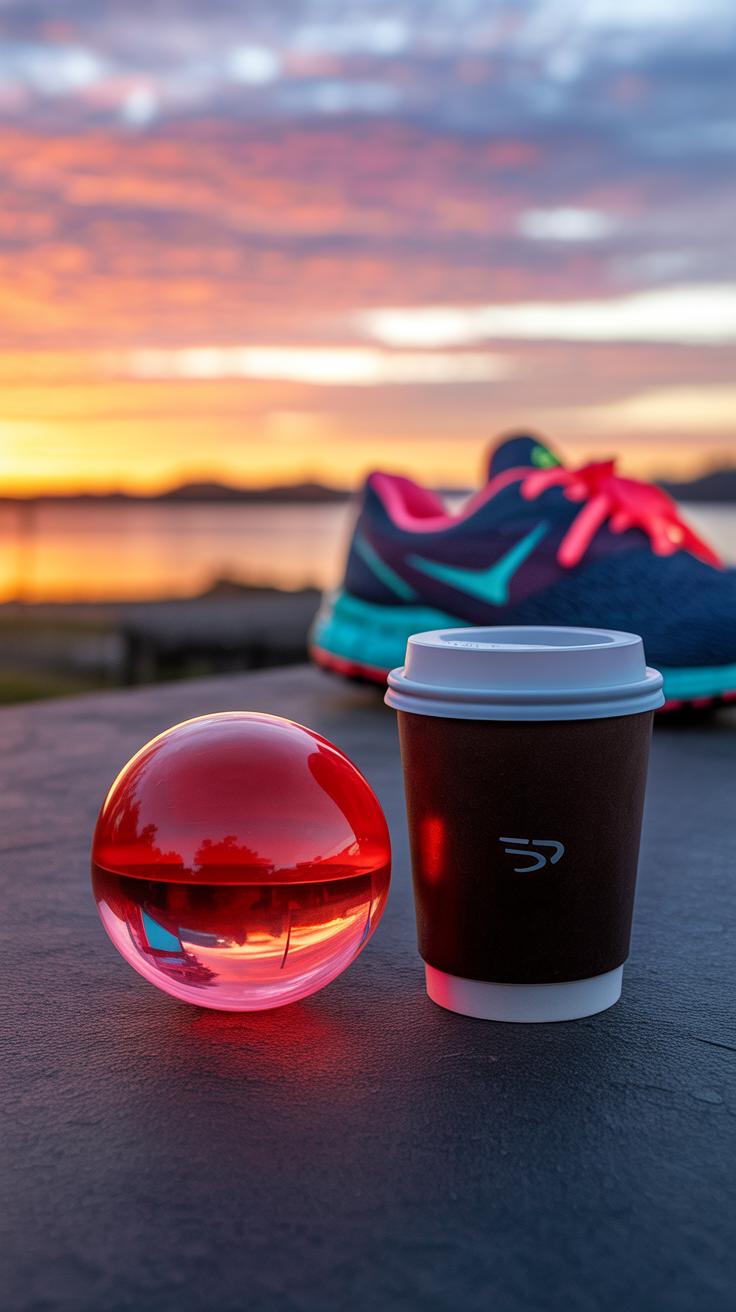Introduction
If you want a quick and healthy snack to power your workouts, high protein energy balls are a great choice. They combine proteins, healthy fats, and carbohydrates in a compact form to fuel your body and help your muscles recover faster. These snacks are easy to make and carry with you anywhere.
In this article, you will learn why protein energy balls are beneficial for your fitness routine and explore simple recipes to make your own. Whether you exercise regularly or just need an energy boost during the day, protein energy balls can become your nutritious go-to snack.
What Are Protein Energy Balls
Protein energy balls are small, bite-sized snacks packed with a mix of nutrients designed to fuel your body, especially when you’re on the move or recovering from exercise. Think of them as concentrated powerhouses made mainly from protein sources combined with carbs and fats, all rolled into convenient little spheres.
These balls usually have a chewy texture and a naturally sweetened taste, which makes them easy to eat anytime you need a quick boost. They’re meant to be a better option than typical sugary snacks, offering sustained energy and helping muscle recovery rather than just a short sugar rush.
Common Ingredients
If you look at the common components, you’ll often find nuts—like almonds, peanuts, or cashews—because they bring healthy fats and protein. Seeds such as chia, flax, or sunflower seeds add fiber and omega-3 fatty acids.
Protein powders are a staple too. Whey, plant-based, or collagen powders tend to bulk up the protein content. Sweeteners are usually natural, like honey, maple syrup, or dates, since they bind the ingredients and provide a touch of sweetness without relying on refined sugar.
Sometimes oats or other grains make an appearance, adding carbohydrate content and texture. It’s a fairly simple formula but mixing these ingredients in the right balance is key to making them taste good and feel satisfying.
How They Support Energy
Why does this combination work so well for energy? It’s because protein energy balls pack all three macronutrients: protein, carbohydrates, and fats. Each plays a role in keeping your energy steady.
Proteins help with muscle repair while carbs serve as quick fuel. The fats, mostly from nuts and seeds, slow digestion a bit, which helps energy last longer. So, instead of crashing after a sugary snack, these balls keep you alert and nourished.
Have you noticed that sometimes after a workout your energy just dips? Food like this can help stabilize those swings, making sure you recover without feeling drained. It’s this blend that makes protein energy balls a popular choice for anyone wanting to stay energized and support muscle recovery at the same time.
The Role Of Protein In Workout Nutrition
Protein And Muscle Repair
When you work out, especially if it involves strength training or intense activity, your muscles undergo tiny tears. That sounds worse than it is—it’s a natural part of how your body adapts and becomes stronger. Protein plays a key role here. Think of protein as the building blocks your muscles need to heal and grow back stronger.
Your body breaks down protein into amino acids, which then get used to fix those little tears. Without enough protein, this repair process slows down. You might feel more sore or notice slower progress. I’ve noticed that after some workouts, eating protein right after really helps reduce that stiffness. It’s not magic, but it works.
Recommended Protein Intake For Active People
How much protein should you actually eat? Well, it depends on your activity level and goals, but a simple guideline can help. For most active people, aiming for around 1.2 to 2 grams of protein per kilogram of body weight per day is a decent target. So, if you weigh 70 kilograms (about 154 pounds), that means somewhere between 84 and 140 grams daily.
That range might seem wide, and it is—because needs vary by person. Someone doing light exercise won’t need as much as someone training hard daily. Also, timing can matter. Spreading protein intake through your meals and post-workout snacks (like those protein energy balls) can help your body make the most of it.
So, think about how active you are, and adjust accordingly. And don’t stress too much over exact numbers; consistency matters more than perfection here.
Benefits Of Protein Energy Balls For You
Convenient And Portable
Protein energy balls are surprisingly easy to carry around. Just toss a couple into your bag or keep them in your desk drawer. No need for utensils or refrigeration most of the time, which makes snacking on the go pretty straightforward. I’ve found they work well for those days when plans change unexpectedly—there’s no fuss and no mess.
They fit perfectly into busy routines, whether you’re heading to the gym, running errands, or even during a quick break at work. Since they come in small sizes, you don’t have to commit to a full meal. Sometimes it’s just about having that quick burst of energy without slowing down your day. You might wonder if a snack this small can really keep you going—sometimes it really does.
Healthy And Balanced Nutrients
What stands out about protein energy balls is how they marry different nutrients without overloading you. They bring together protein, healthy fats, and carbs in a manageable bite. This mix doesn’t just pump you full quickly—it fuels you steadily. Say you’ve had a light lunch or need a top-up before your workout; these balls can keep energy levels more stable than a sugary snack.
That balance helps muscle recovery too. You’re not just eating protein alone but also vitamins and minerals from nuts, seeds, or other add-ins. Sometimes, it feels like reaching for a protein bar is easier, but energy balls can pack similar benefits with fewer processed ingredients. You might even find they satisfy cravings better while leaving you feeling lighter.
Key Nutrients Found In Protein Energy Balls
When you bite into a protein energy ball, you’re getting more than just a quick snack. These little bites pack a combo of nutrients that work together to support your workouts and recovery. Let’s break down what they typically contain and why these components matter.
Proteins And Amino Acids
Protein is the star player here. Your muscles rely on it for repair and growth, especially after exercise. But protein isn’t just a building block; it also provides amino acids, which are crucial for many body functions. Some of these amino acids your body can make, but a few must come from your diet—these are called essential amino acids.
Think of them as tiny messengers and repair workers rolled into one. They help rebuild muscle fibers torn during workouts. Without enough protein and amino acids, muscle recovery slows down, and you might feel more tired or sore than usual. So snacking on a protein energy ball offers a practical way to keep those repair processes running smoothly.
Fats And Carbohydrates
Don’t be scared off by fats and carbs—they’re actually essential, especially if you’re active. Healthy fats, often from nuts or seeds in energy balls, do more than just fuel your body. They support brain function and hormone production, which you might overlook but are quite fundamental for overall energy balance.
Carbohydrates here are usually complex carbs, releasing energy steadily rather than in a sugar spike. That slow release helps you push through workouts and keeps your energy from crashing afterward. Sometimes I wonder if people focus too much on cutting carbs, forgetting these snacks provide the right kinds that actually aid performance.
Put simply, these components aren’t working in isolation. Protein repairs, fats nourish, and carbs energize. Together, they create a snack that’s more than the sum of its parts—it’s a practical energy source and a recovery tool all in one.
Choosing The Right Protein Sources
Picking the right protein for your energy balls can feel a bit tricky. There are lots of options: whey, plant proteins, nuts… each brings its own set of perks and quirks. Whey protein, for instance, comes from milk and is quickly absorbed, making it popular among those who want a speedy muscle recovery. It’s often favored by gym-goers, but if dairy doesn’t sit well with you, going plant-based might be a better fit.
Plant proteins, like pea, hemp, or brown rice protein, tend to digest a bit slower but usually come packed with fiber and other nutrients too. Sometimes this makes them more filling, which can be a plus when you want a snack that keeps you going longer. Nuts, beyond protein, add healthy fats and texture — think almonds, walnuts, or cashews. They might not offer as much protein per serving as powders, but they contribute to the overall nutrient profile and taste.
Animal-Based Vs Plant-Based Proteins
Animal-based proteins, such as whey or egg whites, offer a complete amino acid profile. They’re often more bioavailable, meaning your body uses them efficiently. That’s great for muscle repair after tough sessions. Yet, some people might experience digestive issues or just prefer to skip animal products altogether.
Plant proteins aren’t always “complete” on their own, but by combining sources—like rice and pea protein—you get a similar amino acid spread. Plus, plant-based choices often bring antioxidants and fiber along, which animal proteins lack. It’s a trade-off, really — do you prioritize digestibility and quick absorption, or the extra fiber and nutrients?
Allergies And Dietary Preferences
Allergies can narrow your options. If you’re allergic to dairy, skipping whey is obvious, but nuts can also cause reactions for many. In those cases, seed proteins like pumpkin or sunflower seeds could be worth exploring. They’re less common but pack a punch.
For special diets—vegan, paleo, gluten-free—it’s good to read labels carefully. Some protein powders or nut butters have additives or fillers that don’t fit certain lifestyles. Gluten isn’t a direct protein issue, but cross-contamination can be a concern.
At the end of the day, flexibility matters. Trying different proteins might show you what works best for your taste and digestion. Perhaps you start with whey for convenience, then experiment with a blend of plant proteins and nuts to see how your body and palate respond.
How To Make Protein Energy Balls At Home
Basic Recipe And Preparation
You don’t need fancy equipment to make protein energy balls. Most of the time, a mixing bowl, a spoon, and your hands will do just fine. Start with about a cup of rolled oats, half a cup of nut butter—peanut or almond versions work well—and roughly a third of a cup of protein powder. Add a handful of mix-ins like chopped nuts, seeds, or dried fruit for texture.
Combine everything in the bowl and stir thoroughly. It might feel a bit crumbly at first, but keep mixing. If the mixture won’t hold together, add a tablespoon of honey or a splash of water to help bind it. When it’s sticky and holds its shape, pinch off small portions and roll them between your palms until you get firm little balls, about one inch in diameter.
Tips For Storing And Serving
Store these balls in an airtight container, preferably in the fridge. They’ll last about a week there. If you want them to keep longer—say, a couple of weeks—freezing works well too. Just take them out a few minutes before eating. The texture softens slightly as they warm to room temperature, which I actually like better sometimes.
Serving is flexible. Grab a couple before your workout or keep them handy during a busy day. On occasion, I toss a few energy balls onto a salad or blend them into a quick snack bowl with yogurt. It’s not always about eating them as-is. Have you tried cutting one in half and sprinkling it with a bit of cinnamon or cocoa? Might surprise you a bit.
Flavor Variations To Keep Things Interesting
Sweet Additions
Sweetness is often the first thing people expect from energy balls. But you don’t have to stick to just one basic flavor. Adding honey or maple syrup can bring natural sweetness without overpowering the protein. I’ve found honey works well because it also helps bind everything together slightly more. Dried fruits like cranberries, apricots, or raisins add chewy texture and bursts of flavor. You might be surprised how a handful of chopped dates can turn a simple ball into a mini dessert.
Then there are chocolate chips—classic for a reason. Small dark chocolate chips blend into the mix nicely and give just enough richness. Sometimes I add a pinch of cocoa powder too, especially when using vanilla protein powder. It makes the flavor a bit deeper but doesn’t turn the ball into a chocolate bomb. Sweet additions can be your go-to if you need something satisfying after a long workout or just a little pick-me-up during the day.
Savory And Spicy Twists
Not everyone wants their snacks feeling like candy all the time, right? That’s where savory or spicy options come in. Adding a pinch of smoked paprika or cayenne can surprise your taste buds. It’s subtle but wakes you up more than you’d expect. Some people even mix in finely chopped nuts with a sprinkle of sea salt and cracked black pepper. It’s a bit unusual, but it balances the protein and fat nicely without sweetness.
Herbs like rosemary or thyme, when combined with sesame seeds or a bit of soy sauce powder, can turn a protein energy ball into something almost snackable like a little appetizer. I’ve tried mixing nutritional yeast in too, for a cheesy kind of note. These savory twists are worth a shot if you want to avoid sugar but still crave flavor variety. You might wonder if these will actually fuel your workout—they do, though in a different, maybe less obvious way.
When To Eat Protein Energy Balls For Best Results
Pre-Workout Energy
Eating a protein energy ball before your workout can really set the stage for better performance. If you grab one about 30 to 60 minutes before you start exercising, it gives your body a quick source of fuel without feeling too heavy. The mix of protein, healthy fats, and some carbs helps keep blood sugar steady and muscles energized.
You might notice a difference in how long you can push through your session or how stable your energy feels. Of course, timing can vary a bit depending on your metabolism or how intense your workout will be. Some people prefer to eat right before starting; others need a bit more time to digest. I think finding what works for you is part of the process that makes energy balls useful.
- Provides sustained energy during exercise
- Prevents mid-workout fatigue
- Supports muscle readiness with protein
Post-Workout Recovery
After exercising, your body is craving nutrients to rebuild and recover, and that’s where protein energy balls shine again. Within an hour or so after your workout, having one can jump-start muscle repair and replenish some energy reserves. The protein supplies amino acids your muscles need. The carbs help replace what you burned.
You could say it’s like giving your body a quick recovery boost without a full meal, which might feel too heavy or time-consuming right after training. What’s interesting is how this snack can sometimes curb the temptation to overeat. Maybe energy balls fill that gap without going overboard.
- Aids muscle repair and growth
- Refuels glycogen stores
- Supports quicker recovery between workouts
Avoiding Common Mistakes With Protein Energy Balls
When choosing protein energy balls, one mistake many make is overlooking hidden sugars. You might think they’re a healthy option—but that label can be deceiving. Sometimes, these snacks contain added sweeteners that sneak in extra calories and spike blood sugar. It’s a good idea to really check ingredient lists. Even natural-sounding ingredients like honey or dried fruit can add up quickly. If you’re not careful, you might end up consuming more sugar than you intended, which can work against your workout goals.
Another issue is portion control. These balls pack a punch in terms of nutrition, but eating too many can lead to consuming excess calories. It’s easy to forget that “healthy” doesn’t mean unlimited. I’ve seen people reach for them multiple times a day, thinking they’re filling a nutritional gap, but sometimes it just leads to overeating. Try sticking to a reasonable serving size—usually one or two balls—and pay attention to how your body feels afterward.
- Always read labels for sugars—look beyond just “sugar” to ingredients like syrup, juice concentrates, or maltose.
- Consider the calorie content per serving; a small energy ball can still pack 150 calories or more.
- Don’t let convenience tempt you into mindless snacking—set limits if you find yourself reaching for too many.
Have you ever felt energized after eating one but then sluggish after a few more? That might mean your portion got out of hand, or hidden sugars caught up with you. Being mindful helps. And perhaps, in some cases, making your own gives you better control over what goes in. But that’s a topic for later.
Incorporating Protein Energy Balls Into Your Daily Routine
Protein energy balls can be surprisingly versatile when you start thinking beyond just a quick bite between workouts. For instance, during a hectic workday or a school break, grabbing an energy ball instead of reaching for vending machine snacks can keep your focus sharper and hunger at bay longer. They don’t need a fork or plate, making them ideal for on-the-go fuel.
Try keeping a small container of these balls in your bag or desk drawer. When mid-morning cravings hit, one or two can tide you over without the crash of sugary snacks. They also fit easily into travel kits—you can pack them for road trips or flights where healthy options are scarce.
Quick Snack Ideas
Simple ways to enjoy energy balls during busy hours include:
- Pairing one or two with a cup of herbal tea or coffee for a light, uplifting break.
- Adding an energy ball alongside some fresh fruit for variety without much fuss.
- Packing them in small zip bags for a quick grab during school recess or work meetings.
These little protein bombs can make those in-between moments feel less rushed, though sometimes I wonder if just two balls are enough to stave off hunger until the next meal.
Meal Pairings
Energy balls don’t have to stand alone. You can pair them with other foods to round out a meal, especially when time is tight or you want something simple but nourishing.
- Blend them with Greek yogurt and berries for a balanced breakfast or post-workout snack.
- Serve one or two alongside a green smoothie with leafy veggies and a banana, adding texture and an extra hit of protein.
- Include them with a small salad topped with nuts and seeds to boost overall protein and fiber content.
While these combos work well, you might find yourself either wanting a bit more or less depending on your appetite or how intense the workout was. That’s part of the trial and error with snacks like this, I think.
Conclusions
High protein energy balls offer a convenient way to support your workout and daily energy needs. Their balanced nutrients help improve your stamina and muscle recovery. By making them at home, you control what ingredients to use and avoid added sugars or preservatives.
Try the recipes and tips shared in this article to create your favorite versions of protein energy balls. Including them in your diet can keep you energized and satisfied, making your path to health and fitness easier and more enjoyable.

